As city authorities came up with a way to increase the amount of fines on the public lanes
I twist-twirl, I want to confuse…
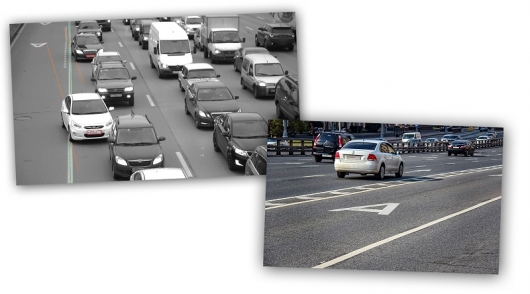
Recently on roads of Moscow dorozhniki have begun to change the marking, separating the public transport lanes from regular lanes of vehicles. Now instead of the standard solid line of the public lane separates marking “Islands of security”. Including the city authorities decided to change the partitioning scheme of public lanes in their places of contiguity. But why do the authorities of Moscow had to change the layout of the public pages? Than not satisfied with the standard solid line, to which all have become accustomed? And how now, without violating traffic rules, you can go to a public lane, as permitted by the SDA, and how to get on the road, crossing a public strip? Our online publication has decided to conduct a detailed analysis of the new markup on the public bands of Moscow with the aim not only to explain the drivers that you now need to do in order not to violate the road law and to try to get to the real reasons that prompted the Department of transport to change the existing layout of the public lanes.
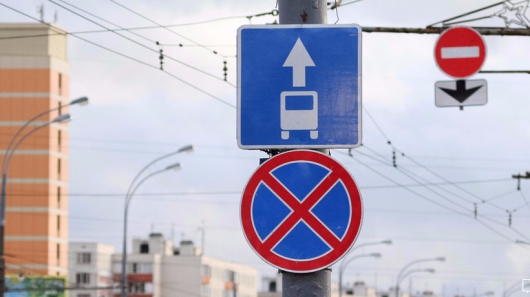
Recall that, according to the official website of the city hall, in Moscow, currently operates 287,56 kilometres of roads and public strip. But the Moscow authorities do not intend to stop there, planning in the coming years to increase the length of the public lanes for another 42 kilometers, opening new areas with dedicated lanes. Also, as reported by the DMV of Moscow, annually on public lanes passing 2.5 million passengers in ground public transport. Including annually lanes for public transport moved approximately 60,000 taxis, which are allowed under the law movement on the lanes. However, taxi drivers are required to have official permission for passenger transportation taxi.
On the one hand, the expansion of the network of public lanes in Moscow allows the authorities to reduce travel time in urban public transport, as in the theory of buses, trolleybuses, minibuses and taxi cars are moving along a public lane with virtually no traffic, since under the law to go ordinary drivers on public lanes is strictly prohibited. For violation of this prohibition are subject to administrative liability in the form of a fine in the amount of 1 500 rubles (part 11 of article 12.17 of the administrative code). But this penalty is applicable only when violation of rules of traffic on public lanes in the territories outside Moscow and Saint Petersburg. For these cities of Federal significance is another penalty provided under part 12 of article 12.17 of the administrative offences code of the Russian Federation, – 3 000 roubles.

But if you often travel on the roads of Moscow, you probably have noticed that in many parts of the public bands, as well as in the normal lanes, there are traffic jams. This means that, in fact, public strip not really cope with its task to improve the speed of urban land transport of Moscow. Why are traffic jams on the public pages? There are several reasons. First, despite quite a large fine for departure on a public lane, many drivers ignore the ban, deliberately violating traffic rules. Second, some sections of the public lanes sooner or later intersect conventional roads at numerous congresses/exits and junctions, where, as a rule, and formed a large tube in the morning and evening rush hours. In the end, public bands are also formed huge queues. So, as you can see, public lanes in Moscow is not the Holy Grail of capital Diptrans, which likes to boast of its achievements in the field of road transport.
But why do so many drivers go to public strip, breaking the law and creating obstacles for the movement thereon of urban transport? Don’t they stop pretty decent fines? No, of course those who deliberately goes on the lanes for public transport and collect the fines, you are unlikely to find (although, to be honest, these drivers are still encountered, especially among the rich Golden youth). But then how many drivers are avoiding the all-seeing eye of numerous cameras photos and video recording, placed along social lines? It’s simple. The camera on these lanes, as a rule, not hanging on every post. Naturally, those who often travel on the same routes, have long since learned where the cameras are, locking out public strip and try in such places as not to get in the camera lens. As a result, these enterprising motorists traveling on the public lane on the sections of roads where they don’t appear on camera. In order to avoid the penalty, sufficiently in advance again to switch from public lanes in regular traffic lane.
But not all drivers deliberately violate traffic regulations, leaving on strips of social movement. We all know that 30-40 percent of the Moscow road traffic accounts for transit traffic. That is, every day on the Moscow roads moving cars whose owners do not reside in the city of Moscow. For example, there are those who came to Moscow for 1 day. There are those who are moving through Moscow in transit.
And most interestingly, according to the statistics and collection of penalties for departure on public strip just the lead not the local drivers who inadvertently, or through ignorance (or the blame for the confusion of road signs and marking), either by mistake go to a public strip, of course, falling under the lens of cameras installed on all public lanes in the capital.
As you know, the lion’s share of revenue in the capital budget from fines with community bands arrives from the pockets of those people who’s not on purpose went to public strip.
But the authorities of Moscow was not enough. Now they have decided, apparently, to increase the collection of fines by public bands due to the introduction of a new marking for designation of public lanes. Recently, the road builders began to change the layout of public lanes, replacing the classic a line on the “buffer zone”. That is, if previously a public lane from the regular lanes are separated by a straight solid line, now the city authorities decided to separate the markup, meaning “Islands of security”.
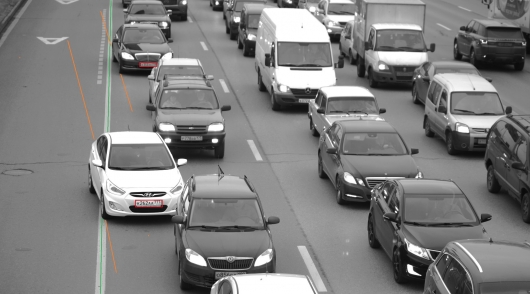
According to the Department of transport, this markup makes public strip more visible (Approx. ed.: like before, the public bar was not visible). But the reality turns out completely different. Yes, a visual social strip do with the new layout can be seen better. But, unfortunately, the city authorities actually have made things complicated for drivers. In fact, this kind of markup confuses drivers. Especially beginners and those who not often visits Moscow and don’t know all the specifics of traffic in the capital. The fact that the marking “Islands of security” (1.16.1 – 1.16.3 SDA RF) is not included according to the legislation in the list of layouts that are forbidden to cross the drivers.
For example, here is a comprehensive list of layouts that are forbidden to cross to drivers today under the current SDA:
– A solid line marking – separates traffic flow of opposite directions and designates borders of lanes in dangerous places on the roads (marking 1.1)
– A solid line marking is the edge of the carriageway of the road (marking 1.2.1)
– Double solid line marking – divides transport flows of opposite directions on roads with four lanes or more (the markup is 1.3)
– A combined line road markings – separates traffic flow of opposite or passing directions on sections of roads, where the rebuild of this markup is allowed only one band (marking 1.11)
Also can not find the ban to cross the marking “Islands of security” you and other points of traffic regulations of the Russian Federation. But why have the authorities decided to designate public strip exactly in the same layout? How so? If such a buffer zone may be crossed, since there is no explicit prohibition of traffic rules, then in the absence of road signs prohibiting movement on public lanes, the drivers can legally go to strip intended for the route of the city bus transport and taxis?
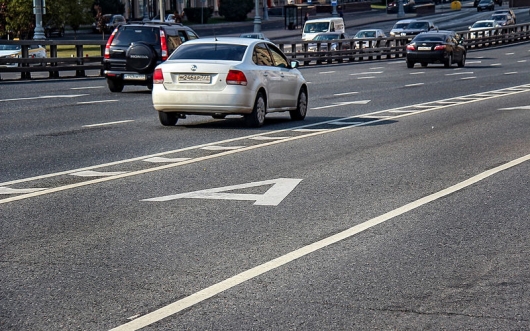
It is not so simple. I hasten to disappoint you. No, the city the DMV is not opened before the election of free movement on public lanes for all modes of transport. In fact, this markup does not allow normal transport to travel into the lane designated for public transport only. Therefore, crossing such markings “Islands of security”, drivers also violate the Administrative code and in the case of committing the offense on camera, controlling traffic on the public lane, the driver will receive a fine of 3 000 rubles.
And the penalty will come, even if for some reason the public lane no road signs warning drivers about the public lane. But how? After all, under current law, if the road lacks road signs, drivers must follow the road markings. And once the markup 1.16.1 – 1.16.3 SDA RF is not spelled out in the SDA as markup that cannot be crossed, and the fine for traffic on the public lane. That may be so. But it is in theory. In practice, many drivers have begun to receive massive fines, who, not understanding the buffer markings on the road, went into a public lane and came under the lens of the camera, who love to hang next to the congresses and departures on public bands.
First, crossing the marking “life raft” that separates the regular lanes from the public, you are in violation of article 12.16.1 KoAP which provides responsibility in the form of a fine in the amount of 500 rubles (Failure to comply with prescribed traffic signs or road markings). How so? There is nothing in the SDA ban on crossing the buffer layout. But no. Lawyers in the capital, probably knowingly get your sandwiches with caviar and eaten for Breakfast far crab. In fact, what is really new markings on the road separating the public area from the rest of the strips applied in accordance with GOST R 52289-2004 “Technical means of traffic organization”. In this Guest there is one item marked 6.2.3:
1.1 the markings used in the following cases:
…
3) To indicate the boundaries of sections of the carriageway on which entry is prohibited (Islands guide Islands, etc.)
In simpler words, the GOST points directly to the fact that the border of the Islands, denoted by the marking 1.16.1 – 1.16.3 SDA RF, conducted continuous marking 1.1 (solid line). But this markup is just, according to the traffic rules to cross the forbidden.
So, in fact, the Moscow authorities, changing the layout, not changing the rules for the use of public lanes, leaving traffic on them is only for urban public transport and taxis.
So no matter what layout you cross – just a visual single solid line (marking 1.1) or buffer marking (marking of the Islands 1.16.1 – 1.16.3), you will still violate the administrative code, envisaging the penalty of 500 roubles. Also, riding on public strip and continuing the movement, you violate another article of the Administrative code, and in Moscow there is a penalty in the amount of 3 000 rubles.
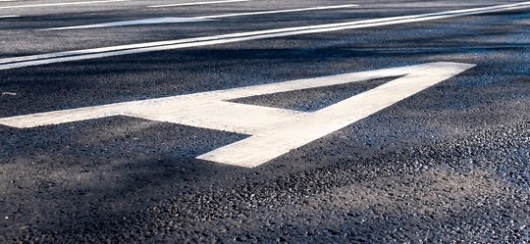
Why did the Moscow authorities are making such a mess on the roads of Moscow? Really it was impossible to keep a normal solid line? And this is all to ensure that the capital budget never-ending replenished by revenues from fines for crossing the markup, which separates the public lane from the regular lanes and, of course, from the proceeds of fines for illegal traffic on public lines, which often carry out transit motorists. Yes, most often not to take notice of public strip almost impossible. Because it is, as a rule, stands out not only road marking and road signs, but has on the road surface of the painted letter “A”. But, unfortunately, such a set of warnings about the public lane on all the roads of the capital.
But that’s not all. The DMV decided to change the marking in the places where you can turn right, passing through vydelenku. We will remind that until recently in the entire country (including the Metropolitan region) the solid line of the public lines are not interrupted even in places where it is allowed right turn, and the zones that allow turns through dedicated lanes for public transport, designated by the additional dashed lines.
Now the authorities have decided to change in places the layout of the public band. So, now the road builders removed the solid line leased in places turns. That is, according to the SDA, in places right turns designated lane ends. After the turn of the public lane starts again.
On the one hand, this will have been long overdue. But not so simple as it seems at first glance.
For example, questions remain, such as the buses that move on the public lanes in places right turns. Again, according to SDA, for right turns public strip according to the new markup ends and continues after the turn over, it turns out, in the case of a road sign “right Turn only” public transport in such areas for movement will have to be reconstructed to the right, I’ll go with the extreme strip not to break the order of the sign.
